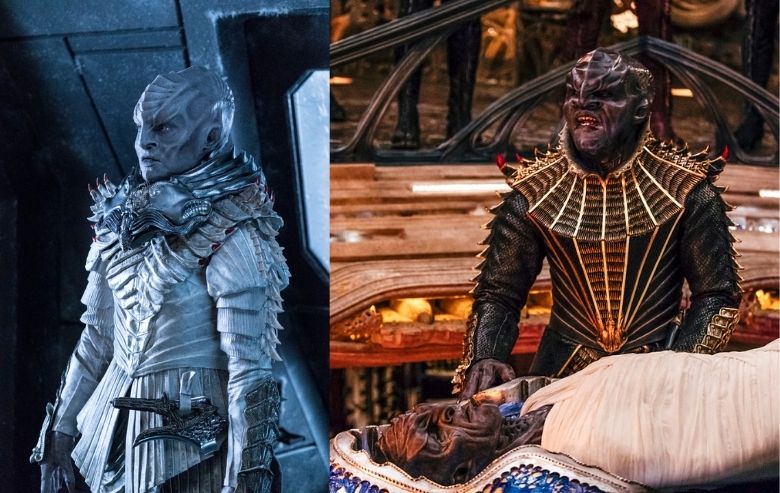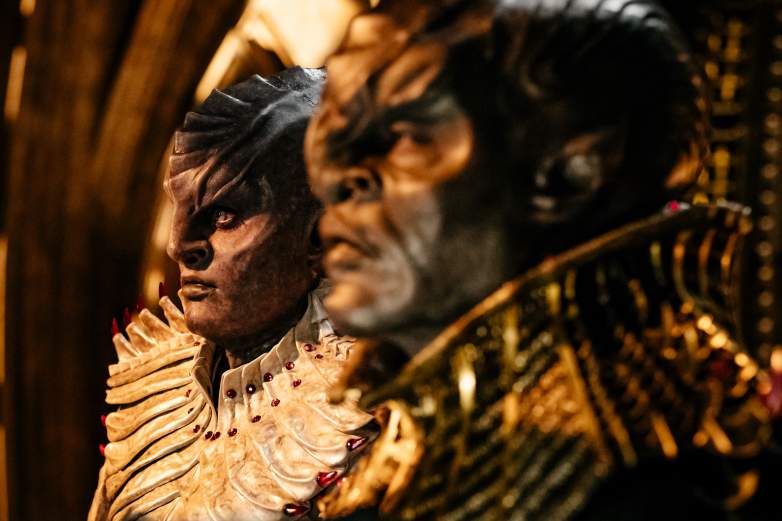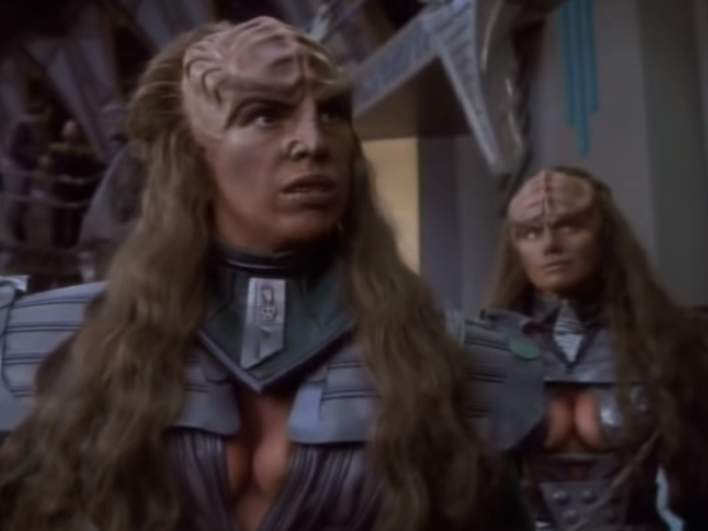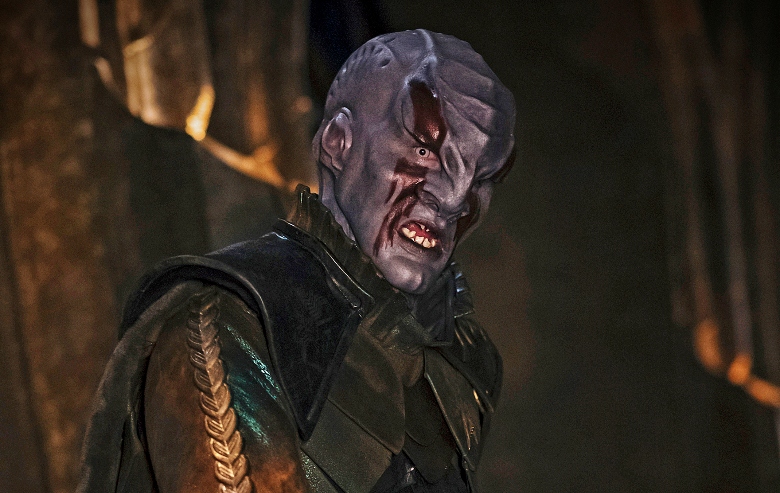
Jan Thijs/CBS Interactive Klingons from "Star Trek: Discovery"
The redesign of the Klingons for Star Trek: Discovery may be one of the most controversial topics in the Trek fandom. When fans first saw the new Klingons, many were very upset that the newest installment in their favorite franchise had seemingly chosen to ignore the established Star Trek canon.
Klingons had looked the same for over three decades and there were several canon reasons why they looked the way they did. Yet, Discovery chose to go in a completely different direction with the popular Trek aliens.
Classic Klingons vs. ‘Discovery’ Klingons

YouTubeKlingons from “Star Trek: The Motion Picture”
Since Star Trek: The Motion Picture, the appearance of the Klingons had remained generally the same. Though each Klingon had different forehead ridges, every Klingon had distinct forehead and nose ridges, a dark skin tone, lots of hair, which was usually worn long and loose, bushy eyebrows and facial hair.
Discovery’s Klingons were a vast departure from this uniform look. They had two very different skin tones: a gray shade and a charcoal shade. The forehead ridges were much more prominent. Smaller ridges spread across the forehead and converged to form a massive ridge along the center of the forehead, which stretched all the way down the back of the head. Additional ridges stretched over the temples, all the way to the back of the head, converging with the center ridge.
Their noses were much wider with much more distinctive ridges. Their cheekbones were heightened and sharpened, giving a sunken appearance to the eyes. And they were completely bald. No hair or facial hair, which was always a defining feature of classic Klingons.

Jan Thijs/CBS InteractiveKlingons from “Star Trek: Discovery”
With classic Klingons, the bottom half of the actor’s face was usually visible, but with Discovery’s Klingons, none of the actor’s face was visible. While classic Klingons had prosthetics applied to their foreheads, Discovery’s Klingons wore full face masks. Discovery’s Klingons also had clawed fingers, sharper teeth, and subdued ears that blended into the sides of their heads.
Overall, Discovery’s Klingons looked much more like aliens than the classic Klingons did. Though classic Klingons certainly didn’t look like humans, they looked much more humanoid than the monstrous creations of the Discovery makeup and visual effects departments.
‘Discovery’ Team Insists the Changes Align With Canon

Jan Thijs/CBS InteractiveKlingons in “Star Trek: Discovery” season one
In response to massive backlash over the changes to the Klingons, Discovery’s showrunners, visual effects team, and actors all responded that the changes were actually completely in line with the established Star Trek canon. They also gave details about the backstory of these particular Klingons, which helped justify their appearance.
At Star Trek Las Vegas a month before the show premiered, the biggest Star Trek convention in the U.S., the actors playing the new Klingons talked about some of the reasons their Klingons were so different as TrekMovie.com reported.
Mary Chieffo, who played L’Rell, insisted that there were canon reasons for each of the design choices, however, she didn’t detail what they were.
Obviously the hair was the biggest thing people noticed, or the lack thereof. And I will attest to the fact there is a reason my ridge goes back the way it does… There is a whole reasoning behind it that is adhering to what has always been true in Klingon canon… So I deeply believe we are in line with what has come before but is also adding a new kind of nuance.
Kenneth Mitchell, who played Kol, gave a more in-depth answer as to why his character looked different even from the other Discovery Klingons.
The series itself is going to explore 24 different houses and the leaders among them… You are going to start to explore further into the Klingons, and each of those houses has a different set of physical looks and variations as well as ideologies.
Though neither Chieffo nor Mitchell cited their Star Trek sources to back up their assertions, they did have some basis in established Star Trek lore.
According to The Making of Star Trek: The Motion Picture, Star Trek‘s creator, Gene Roddenberry, envisioned the Klingon’s forehead ridges as an extension of their spinal column. Essentially, their spines stretched up their necks, over the back of the head, all the way to the forehead. The book also established that the classic Klingon’s hair covered up these ridges. Presumably, this is what Chieffo was referencing when she said that there was a specific reason her ridges extended to the back of her head.
Mitchell’s explanation that Klingon appearance changes based on which House they’re from is also backed up by canon. According to Star Trek: Aliens and Artifacts, there were several different designs for the classic Klingon forehead ridges, which became aligned with the different Klingon Houses as more Klingons appeared on the show.

YouTubeJ.G. Hertzler as General Martok on “Star Trek: Deep Space Nine”

YouTubeThe Duras Sisters, Klingons from “Star Trek: The Next Generation” and “Star Trek: Deep Space Nine
This lore explanation is backed up by the visual similarities between Klingons from the same House and the marked divergences between the Klingons from different Houses. For example, the forehead ridges of the Duras sisters look similar, while Gowron and Martok’s forehead ridges look very different.
The baldness of the Discovery Klingons was one of the few appearance changes that were explicitly explained in an episode of the show. In the second season episode “Point of Light,” the Klingons revealed that they shave their heads when they’re at war, a tradition passed down directly from Kahless.
Throughout the history of Star Trek, the Klingons have almost always been at war with some species, however, they’ve never been bald until Discovery. So, how does this explanation fit with canon?
A Different Klingon Evolution

CBS Interactive
Discovery’s showrunners and visual effects team were obviously aware that they were making significant changes to a beloved Star Trek species. They knew that they would have to come up with some really good, in-story reasons for those changes to legitimize them.
The explanation that they came up with was that Discovery’s Klingons were part of a hyper-traditional, hyper-religious sect that had split from the Klingon Empire centuries ago. They remained isolated for over 200 years, which presumably led them to evolve differently than classic Klingons.
In an interview with SFX Magazine, as quoted by TrekMovie.com, Discovery’s co-executive producer, Ted Sullivan, confirmed that the show’s Klingons had a very different history than the Klingons featured in the previous shows.
“It’s a 200-year-old ship. This is a group of Klingons who’ve gone back to a puritan way of life. They look very different: they wear armour that’s 200 years old and they don’t have any hair. Their commander runs his Klingon house – the house of T’Kuvma – by the rules of Kahless, the Klingon messiah. And he calls himself the second coming of the Klingon messiah.”
In an interview with SyFy Wire, Glenn Hetrick, one of the designers responsible for the new Klingons, explained how their look was indicative of this different history. He said that there was one story in the Star Trek canon where Kahless cut off his hair, threw it in lava, waited until it hardened, and used it to make the first bat’leth, the iconic Klingon battle weapon. Hetrick said that his team became so obsessed with the story of Kahless cutting his hair that they decided to make the Klingons bald.
So, this sect of Klingons evolved differently from their brethren, apart from all the rituals and traditions of their kin. This led them to not only look different but also alter their appearance based on their understandings of the sacred stories.
Though these explanations may seem like a stretch to hardcore Star Trek fans, all of the choices made in the Klingon redesign did have a basis in the established Star Trek canon.
READ NEXT: What Does the Actor who Played Martok Look Like Without Klingon Makeup?